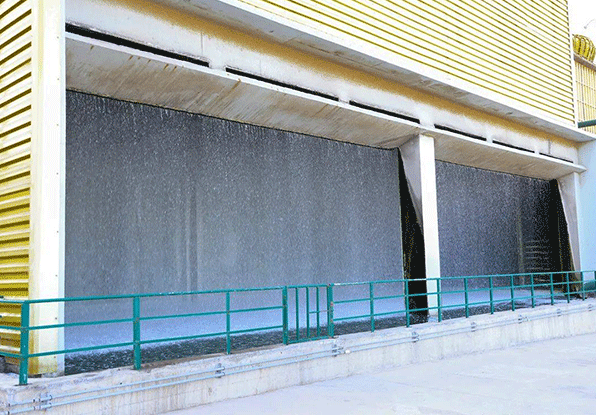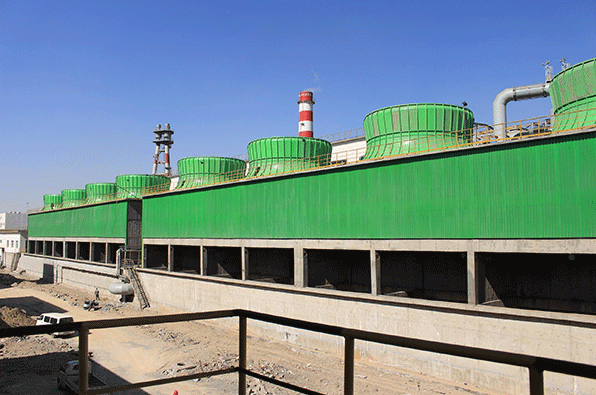Video: Cooling Tower Troubleshooting and Solutions

Figure 1: Cooling towers.
Cooling towers are commonly used equipment in industry, air conditioning and other fields, and are used to remove
the large amounts of heat generated during the production process.
During the use of cooling towers, various faults may be encountered. How to detect faults and deal with them in time
has become the key to ensuring the normal operation of the cooling tower. This article will introduce in detail
common faults and corresponding handling methods about cooling towers.
1. Common Cooling Tower Failures and Corresponding Solutions
1.1 Cooling Tower Leakage
Cooling tower leaks are a common failure, often caused by loose fill, aging pipes, or poor pipe connections. Leakage
will reduce the cooling effect of the cooling tower, and in severe cases may affect the surrounding environment.
How to deal with cooling tower leaks:
If a cooling tower leaks, please first find the location of the leak, and then repair or replace it accordingly. If
the leak is caused by loose fill or poor pipe connection, please try to replace the fill material or retighten the
pipe connection; if the leak is caused by aging pipes, replace the pipe.
1.2 Abnormal Cooling Tower Water Level
Abnormal cooling tower water level is also a common fault, including too high or too low water level. It is usually
caused by blocked water inlet pipe, water pump failure or
water level switch failure. Abnormal water levels will prevent the cooling tower from working properly and affect
production efficiency.
How to deal with abnormal cooling tower water level:
The method of handling abnormal cooling tower water level needs to be selected according to the specific situation.
If the abnormal water level is caused by a blocked water inlet pipe, you can clean the pipe; if the abnormal water
level is caused by a failure of the water pump, you need to replace the water pump; if the abnormal water level is
caused by a faulty water level switch, you need to replace the switch.

Figure 2: Cooling tower water level.
1.3 Cooling Tower Water Quality Issues
Cooling tower water quality problems are also a common failure, mainly manifested as scale or contamination, usually
caused by improper use of water treatment agents or poor cleaning. Water quality problems will affect the cooling
effect of the cooling tower and reduce production efficiency.
How to deal with cooling tower water quality problems:
The solution to cooling tower water quality problems requires regular inspection of water quality, timely
replacement of water quality treatment agents, and cleaning. If problems such as scale, ice, or contamination occur,
please clean the cooling tower and replace water treatment agents.
1.4 Cooling Tower Fan Failure
Cooling tower fan failure is a common failure, mainly including
excessive noise or failure to start normally. It is usually caused by aging of the fan bearings, damaged motor or power line failure.
How to deal with cooling tower fan failure:
The solution to cooling tower fan failure requires first finding the specific cause of the failure, and then
performing corresponding repairs or replacements. If the failure is caused by the aging of the fan bearings, you can
replace the bearings; if the failure is caused by motor damage, you need to replace the motor; if the failure is
caused by a power line failure, you need to repair the power line.

Figure 3: Cooling tower fan.
1.5 Insufficient Ventilation
Cause Analysis:
1. The fan speed decreases (the transmission belt is loose or
the bearings are poorly lubricated).
2. The angle of the fan blades is inappropriate.
3. Damaged fan blades.
4. The fill material is partially blocked.
Solutions:
1. Adjust the tightness of the motor belt or replace the belt, or add lubricating oil or replace the bearings.
2. Adjust to the appropriate angle.
3. Repair or replace.
4. Clear the blockage.
1.6 Outlet Water Temperature Too High
Cause Analysis:
1. The amount of circulating water is too large.
2. Insufficient ventilation.
3. The inlet water temperature is too high.
4. Partial blockage of the fill causes bias flow.
5. Outdoor wet bulb temperature is too high.
Solutions:
1. Adjust the valve to get the appropriate water volume, or replace the cooling tower with one having matching
capacity.
2. See solutions refer to the above “insufficient ventilation".
3. Check the reasons from the respect of the chiller unit.
4. Clear the blockage.
5. Reduce cooling water volume.
1.7 Water Collection Basin Overflows
Cause Analysis:
1. The water outlet (filter) of the water collection tray is blocked.
2. The float valve fails and cannot close automatically.
3. The amount of circulating water exceeds the rated capacity of the cooling tower.
Solutions:
1. Clear the blockage.
2. Repair.
3. Reduce the amount of circulating water or replace the cooling tower with one having matching capacity.

Figure 4: Cooling tower inner structure.
1.8 Low Water Level in the Water Collection Basin
Cause Analysis:
1. The opening of the float valve is too small, resulting in a small amount of water replenishment.
2. Insufficient water replenishment pressure, resulting in small water replenishment volume.
3. There is a leak in the piping system.
4. Excessive water loss during the cooling process.
5. The diameter of the water supply pipe is too small.
Solutions:
1. Let the float valve open to a suitable opening.
2. Raise the pressure or increase the pipe diameter.
3. Find out where the water is leaking and solve it.
4. Use manual replenishment devices to replenish water in a timely manner.
5. Replacement.
1.9 Obvious Phenomenon of Water Mist Drifting out
Cause Analysis:
1. The amount of circulating water is too large or too small.
2. Ventilation volume is too large.
3. There is bias flow in the fill material.
4. The water distribution device rotates too fast.
5. Improper installation position of the drift eliminator.
Solutions:
1. Adjust the valve to get the appropriate water volume, or replace the cooling tower with one having matching
capacity.
2. Reduce the fan speed, adjust the fan blade angle or replace the fan with one having appropriate air volume.
3. Find out the cause and make it flow evenly.
4. Adjust to appropriate speed.
5.Adjustment.

Figure 5: “White smoke" from the cooling tower.
1.10 Uneven Water Distribution
Cause Analysis:
1. Part of the water outlet holes of the water distribution pipe are blocked.
2. The amount of circulating water is too small.
Solutions:
1. Clear the blockage.
2. Increase the amount of circulating water or replace the cooling tower with one having matching capacity.
1.11 Water Overflows from Distribution Basin
Cause Analysis:
1. The water outlet holes of the water distribution basin are blocked.
2. The water supply is too large.
Solution:
1. Clear the blockage.
2. Adjust to get the appropriate water volume or replace the cooling tower with one having matching capacity.
1.12 Unusual Noise or Vibration
Cause Analysis:
1. The fan speed is too high and the ventilation volume is large.
2. The bearing is short of oil or damaged.
3. Fan blades collide with other parts.
4. The nuts of the fastening bolts of some parts are loose.
5. Fan blade screws are loose.
6. Friction between belt and protective cover.
7. The gearbox is short of oil or the gear set is worn.
8. Friction between the drift eliminator and the fill material.
Solution:
1. Reduce the fan speed, adjust the fan blade angle or replace the fan with one having appropriate air volume.
2. Add lubricating oil or replace the bearing.
3. Find out the cause and solve it.
4. Fasten.
5. Fasten.
6. Tension the belt and tighten the protective device.
7. Add enough lubricating oil or replace the gear set.
8. Adjust the drift eliminator or the fill.
1.13 Too Loud Water Dripping Sound
Cause Analysis:
1. Bias flow of water under the filling.
2. Excessive water volume for cooling.
Solution:
1. Find out the cause and make it flow evenly.
2. Reduce the water volume.

Figure 6: Water dripping at the bottom of a water tower.
2. Cooling Tower Noise Control
Cooling towers are widely used in cooling water circulation systems such as urban hotels, restaurants, shopping
malls, and office buildings. They are also widely used in industrial enterprises such as petroleum, chemicals, power
generation, and metallurgy.
Cooling tower noise sources mainly come from:
1) Fan air intake and exhaust noise;
2) Water splashing noise;
3) Fan reducer and motor noise;
4) Noise from cooling tower water pumps, piping and valves
2.1 Control Methods
1. Control the noise at the air inlet and outlet of the cooling tower, and use different noise reduction equipment
such as mufflers and sound insulation barriers according to the situation.
2. To control the noise caused by water spraying on the tower body, different noise reduction equipment such as
sound insulation rooms and sound insulation barriers are used according to different situations.
3. To control the noise of falling water in the water collection basin, use different noise reduction equipment such
as sound-absorbing water mats and falling water mufflers according to the situation.
4. To control cooling tower vibration, use vibration damping equipment such as shock absorbers and rubber soft
joints.

Figure 7: Cooling tower building.
Special note: While controlling cooling tower noise, the operating ventilation needs of the cooling tower must be fully considered based on the actual conditions to ensure that the noise reduction equipment cannot affect the operation of the cooling tower after being installed.
3. Conclusion
To sum up, the treatment methods for common cooling tower failures need to be selected according to the specific situation. Through regular inspection and maintenance, faults can be avoided, the normal operation of the cooling tower can be ensured, production efficiency can be improved, and maintenance costs can be reduced.



